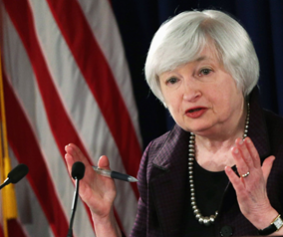As was widely expected, the Fed Open Market Committee (FOMC) left the Fed Funds rate unchanged at 0.25%-0.50% yesterday. What was surprising in the statement and the projections was the fact that the Committee cut in half the projected number of rates hikes for this year and next.
The Fed signaled late last year that there would be four rate hikes this year. At this meeting, the FOMC reduced that number to only two rate hikes this year. The Committee’s projections show the Fed Funds rate, currently at 0.36%, rising to only 0.90% by the end of this year. That’s down from the December projection of 1.4%.
The Committee also decided to cut in half the anticipated number of rate hikes in 2017 from four to only two. The Committee’s projections show the Fed Funds rate at only 1.9% by the end of next year. That’s down from the December projection of 2.4%.
The Fed noted that the economy continues to grow at a “moderate pace despite the global economic and financial developments of recent months.” However, in the Fed’s economic projections, they trimmed their estimate of 2016 GDP growth from 2.4% to 2.2%. They also trimmed 2017 GDP growth from 2.2% to 2.1%. The Fed also trimmed its inflation target for 2016 from 1.6% in December to 1.2% – I’ll have more to say about this next week.
At her press conference following the meeting, Chair Yellen explained that in light of the global economic and financial risks since the first of the year, the Committee felt that such an adjustment was in order. Stocks rallied strongly just after the announcement.
Now the attention will shift to the April 26-27 FOMC meeting, but I continue to expect the next rate hike to a range of 0.5% to 0.75% will come at the June 14-15 meeting.
Americans’ Economic Anxiety Persists Despite More Jobs
By some measures, the US economy has improved in the last several months, especially when it comes to jobs. Job growth has averaged more than 250,000 a month since the fall, and the unemployment rate has fallen to 4.9%.
Yet that hasn’t translated to lower levels of economic stress, according to the latest Marketplace Economic Anxiety Index, which I ran across for the first time this week.
The Economic Anxiety Index is a number that measures a person’s level of financial stress. It is based on a person’s responses to about a dozen questions regarding an individual’s economic situation. It’s on a scale from zero to 100, and the higher the number, the more stressed out someone is.
In the latest reading for Winter 2016, the nation as a whole came in at an anxiety level of 31 – unchanged from the prior reading for Fall 2015. So why didn’t the number budge? Marketplace writer Doug Shaw says it means that many Americans continue to feel anxious about their economic situation, their jobs and meeting monthly expenses.
Here’s a look at the latest figures broken down by mean score, wage, age and race:
Among the more than 1,000 people surveyed by Edison Research, more than 60% reported feeling at least some anxiousness about their financial situations, while 30% said concern over their financial situation is causing them to lose sleep.
The level of anxiety is higher among hourly workers compared to those who earn a salary, while those who identified as African American and Hispanic reported higher economic anxiety levels than whites. The survey found that renters have higher financial stress levels than those who own their homes.
The cool part about this indicator is that you can measure your own financial anxiety level by taking the online survey. Just answer the dozen or so multiple-choice questions, and it will immediately score your financial anxiety level. It only takes a few minutes.



